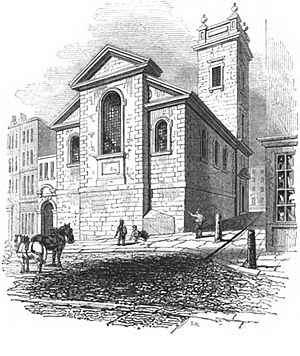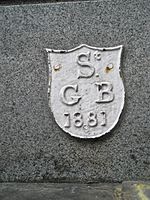St George Botolph Lane facts for kids
Quick facts for kids St George Botolph Lane |
|
|---|---|
 |
|
| Location | London |
| Country | United Kingdom |
| Denomination | Church of England |
| History | |
| Founded | 13th century |
| Architecture | |
| Architect(s) | Christopher Wren |
| Style | Baroque |
| Closed | 1890 |
| Demolished | 1904 |
St George Botolph Lane was an old church in London, England. It was located near a street called Eastcheap in an area known as Billingsgate. The back of the church looked out onto Pudding Lane, which is famous as the place where the terrible Great Fire of London started.
This church was first mentioned in the 1100s. Sadly, it was completely destroyed in the Great Fire of 1666. After the fire, it was one of 51 churches rebuilt by the famous architect Christopher Wren. However, the church was later taken down in 1904.
About St George's Church
This church was special because it was the only one in the City of London named after Saint George. Saint George is known as the patron saint of England. A patron saint is like a special protector or guide for a country or group of people.
There were also churches named after St Botolph, an old Anglo-Saxon saint who protected travelers. Churches dedicated to St Botolph were often built near city gates. Today, three churches in London are still named after St Botolph. St George's church was on Botolph Lane, which was named after another St Botolph church that was also destroyed in the Great Fire and never rebuilt.
The earliest record we have of St George's church is from a document in 1180. It was called "St. George's in Estehepe" back then. Over time, it had other names like "St. George the Martyr near Estchep" and "Seynt George in Podynge lane." The church was repaired in 1360 and again in 1627. A writer named John Stow said that the church's old monuments were well-preserved.
A mayor of London named Adam Bamme was buried at St George Botolph Lane. He died in 1397 while he was still mayor.
Rebuilding After the Great Fire
After the Great Fire, the area around St George's church was joined with the area of another church, St Botolph Billingsgate. The rebuilding of St George's started in 1671. Workers used stones and rubble from the old St Paul's Cathedral to help build it. They also used stones from the destroyed St Botolph's church for the walls.
The new church was finished in 1676 and cost about £4,466 to build. One interesting thing about the church was that it was built on a raised platform. The ground there was originally low and sloped towards the River Thames. So, Wren built a flat platform to make the church level.
The new church was roughly square in shape. The front of the church, facing Botolph Lane, had three sections. The middle section stuck out a bit and was slightly wider. The windows on the north and east sides were rounded at the top. The church also had special stone decorations made from Portland stone. The square tower was built inside the northwest part of the church. It had square windows for the bells and a decorative top with flaming urns (vase-like decorations) on the corners.
Inside, the church was about 54 feet (16 meters) long and 36 feet (11 meters) wide. The main part of the church and the side aisles were separated by two columns on each side. The main ceiling was arched and divided into panels, with four round windows. There were also large windows in each wall. The ceilings of the side aisles were flat. The church had a beautiful wooden screen behind the altar called a reredos. The walls were covered with wood panels up to about 9 feet (2.7 meters) high.
Later Years and Demolition
A famous person linked to the church was William Beckford. He was a Lord Mayor of London and a Member of Parliament. A special sword rest used during his visit in 1770 had an inscription. It said he was a "real patriot" who worked hard for his country. This sword rest is now in another church called St Mary-at-Hill.
Because the church was close to the Billingsgate fish market, the streets nearby were often wet and slippery. By the late 1800s, St George's church started to fall apart. The last church service was held in 1890. In 1900, a letter to The Times newspaper said the church was unsafe. It also mentioned that too many bodies in the church's underground burial area were causing a health problem.
The church was officially closed in 1901 and then torn down in 1904. The church's area was then joined with the nearby St Mary-at-Hill church. Many bodies buried in the churchyard were moved and reburied at Brookwood Cemetery. Today, a building called Farryner House stands where the church used to be. However, you can still find the old churchyard gates in Lovat Lane and a special marker showing the church's old boundary on Fish Street Hill.
Many items from St George's church were moved to St Mary-at-Hill. These included the sword rests, plates, royal arms, ironwork, organ, and organ case. The pulpit (where the preacher stands) from St George's is now in St George's church in Southall.


